While we were walking the Camino de Santiago, the Portuguese road, we spent a night in Pontevedra.
Apart from the "a feira" octopus tapas we could enjoy the nightlife in the city and find things like this:

Built almost entirely in the fourteenth century, this convent church of the Franciscans is a masterpiece of the art of the mendicant orders that came to the city at the time of its first splendor. It was declared a historical-artistic monument in 1896. In its interior we can highlight the grave of Paio Gómez Charino, troubadour, admiral of the sea, belonging to one of the noble families of the time.
According to tradition, the convent was founded by Francisco de Asís, who stopped in Pontevedra while doing the Portuguese route of the Camino de Santiago. The building was built between 1310 and 1360, with the financial help of the heirs of Paio Gómez Chariño on a plot of the house of Soutomaior, at that time even outside the perimeter of the city wall.
The church is of late Gothic or ogival style, and was declared a historical-artistic monument in 1896. It has a Latin cross plan, with a single nave, a transept, a wooden roof and headboards with three polygonal apses, covered with ribbed vaults.
The opulence of this construction provoked envy in the members of the Dominican order installed in the city, who had finished their church ten years before, and who decided to start in 1380 the construction of another church greater than the Franciscan one, with five apses. This great height in the construction was due to the great number of economic donations coming from wealthy families, fearful of the death coming from the bubonic plague that ravaged Europe at that time. After the confiscation of Mendizábal the site was uninhabited, and in 1930 the temple was ceded by Royal Order.
